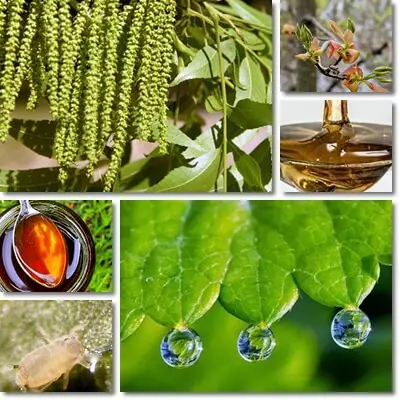Hickory honey is a rare variety of honey made from honeydew collected from insects feeding on hickory tree sap. It is a special type of honey known as honeydew honey or forest honey. Darker colored and stronger tasting than the more common floral honeys we are used to, hickory honey is nonetheless just as nutritious and healthy, being a source of bioactive compounds with antibacterial, antifungal and even antiviral properties, and wound healing benefits. Uses include calming cough, throat soreness, digestive upset in gastritis and heartburn, as well as cosmetic uses.
What is hickory honey?
Hickory honey is a variety of honey made from honeydew secreted by insects that inhibit hickory trees, such as aphids, and collected by honeybees. The raw material for making hickory honey is honeydew, not flower nectar, which is why it’s known as a honeydew honey or forest honey. Technically you can also make a floral hickory honey using flower nectar from hickory flowers which blossom in spring (roughly mid-March to mid-June). All species of hickory can be sourced for honeydew to make hickory honey, and North America is home to over 10 such species of tree, including the pecan (Carya illinoinensis), domesticated for commercial purposes which has resulted in increased habitat.

How is hickory honey made?
Hickory honey is made from honeydew which is a sweet, sugary, sticky, liquid secretion produced by small insects that feed on the sap of hickory trees (e.g. aphids). The honeydew is collected by honeybees and used as raw material for making honey by processing it just as they would flower nectar, using digestive enzymes, then storing it in honeycombs.
Hickory honey can be made from honeydew collected from any hickory species, including the pecan, black hickory, shellbark hickory, nutmeg hickory, red hickory, shagbark hickory, sand hickory, pignut hickory etc. To produce a pure hickory honey bee hives need to be relocated to a forest area full of hickory trees, while ensuring there is minimal temptation nearby in the form of an abundance of wildflowers, flowering crops or flowering trees.
What does hickory honey look like?
Like other honeydew honeys, hickory honey too is darker in color, a medium amber with orangey-brown tones and the occasional faint green reflexes.
Hickory honey may be clear, free of impurities and visual defects, or it may contain pollen particles, air bubbles, even honeycomb pieces.
However, the exact color may differ slightly between one batch of hickory honey to another. Factors such as honey purity, time since harvest etc. can impact honey color.
For example, the presence of flower nectar from various flowering species can change the color of the honey slightly, and so can crystallization.
If enough time passes from production and harvesting until distribution to consumers, the honey can crystallize and set, becoming opaque and turning a light amber color. Crystallized hickory honey is not spoilt – it’s still edible and perfectly safe to eat, not to mention healthy.
What does hickory honey taste like?
Hickory honey is not only darker than regular floral honeys such as acacia or sunflower, but also tastes stronger. In line with honeydew honeys, hickory honey will have a sweet taste sustained by warm, rich flavors and a woody or resinous aromatic profile, with faint bitter notes. The honey is viscous and moderately dense, with a smooth texture. Still, hickory honey is not regarded as a good honey. But in the end that is a matter of personal taste.

Hickory honey crystallization time
How long does hickory honey stay liquid? How long does it take until hickory honey crystallizes? Although hickory species are widely distributed all over North America where they enjoy relatively extensive natural habitats, hickory honey is scarce, only available as a local, artisanal food product. Little is known about its crystallization time, except for the fact that it crystallizes slowly.
However, crystallization time also depends on the age of the honey and any processing it may have undergone (e.g. filtering removes particles that may encourage crystallization and makes a honey crystallize more slowly). To avoid early crystallization, it is advised to not stir the honey unnecessarily, store it in a glass jar in a dark, cool place, and keep it lidded.
Hickory honey nutrition facts
Contrary to what is being written all over the Internet, honey, hickory included, is not nutritionally dense.
It only contains trace amounts of several essential vitamins and minerals such as B vitamins (except vitamin B12), vitamin C, calcium, copper, iron, magnesium, phosphorus, potassium, sodium etc.
In fact, the best represented macro-nutrient in honey in general is sugar, a carbohydrate. Honey is up to 80% to 85% sugar. Sugar in honey occurs in the form of fructose and glucose, two simple sugars.
But while not nutritionally dense, honey, hickory honey included, is a source of bioactive antioxidants, probiotic oligosaccharides, unique enzymes and antimicrobial compounds which are the source of important benefits for health.
Being variety of forest honey, hickory honey contains hydrogen peroxide and glucose oxidase as antimicrobials, same as the famous Halkidiki Greek pine tree honey.
Hickory honey properties
- Classified as a variety of honeydew honey or forest honey
- Scarce, from local production
- Available as raw honey (rarely pasteurized)
- May be filtered or unfiltered
- Non-GMO
- Gluten-free
- Vegetarian (not vegan)
- 100% pure hickory honey, if achievable, is almost pollen-free
- Antiseptic, antibacterial, antifungal, antiviral properties
- Low pH
- High sugar content, but otherwise negligible nutritional value
- Soothing, reparative effects
- Slow to crystallize
16 Hickory honey benefits and uses
- Local antiseptic properties. Bioactive compounds in hickory honey such as hydrogen peroxide and glucose oxidase inhibit bacteria growth, exerting local antiseptic properties and preventing infection.
- Antibacterial properties. Forest honeys such as hickory are a source of antibacterial agents such as hydrogen peroxide and the enzyme glucose oxidase which inhibit bacteria growth and reduce bacterial load. The low moisture content and low pH contribute to the antibacterial effects.
- Antifungal properties. Honey is general has been shown to exert antifungal properties against pathogenic Candida species such as Candida albicans.
- Benefits for low blood sugar. Hickory honey is high in sugar and helps raise blood sugar levels that are too low, helping combat hypoglycemia and associated side effects (lethargy, lightheadedness, headaches, fainting).
- Good for throat soreness. Honey forms a protective coating over the throat lining, soothing irritation and reducing inflammation and associated pain and helping calm a sore throat.
- Good for coughing. Eating raw honey, hickory or another, helps calm cough caused by a respiratory infection or acid reflux and reduces associated discomfort and throat soreness.
- Benefits for upper respiratory tract infections. Raw honey provides antibacterial agents that inhibit bacteria growth and exerts an antiviral action via modulation of the immune system response, helping with respiratory tract infections. The low water content and acidic pH further combat infection and offer relief.
- Benefits for heartburn. Hickory honey helps soothe irritation of the throat and esophagus lining caused by regurgitation of stomach juices in acid reflux disease, relieving heartburn.
- Benefits for gastritis. Any kind of raw honey taken on an empty stomach helps calm digestive upset, reduces stomach pain and inflammation associated with gastritis.
- Benefits for small wounds and burns. Raw hickory honey applied on small wounds or burns creates a protective coating that both soothes and calms pain and inhibits bacteria growth, reducing risks of infection and advancing healing.
- Gentle exfoliating properties. Applying raw hickory honey on the face helps unclog pores, exerting gentle exfoliation.
- Nourishes dry skin. Raw honey in general is nourishing for dry skin and helps combat dryness and dullness.
- Good for oily skin. Used topically, raw honey, hickory or another variety, gently cleans excess sebum without affecting the production of natural oils in the skin.
- Tightening effect. Any raw honey used as a face mask unclogs and minimizes pores, which also reduces sebum production for more balanced skin and improves skin appearance.
- Brightens skin. Unless allergic, use raw honey on dull skin to brighten it.
- Benefits for uneven skin tone. Use raw honey as a face mask to reduce redness and pigmentation in acne scars and blemishes and achieve a more even skin tone.
Hickory honey side effects and risks
- Allergic reactions. It is possible to experience an allergic reaction to hickory honey. The probability of experiencing an allergic reaction is greater if you already have an allergy to honey in general or other honeybee products.
- Contraindications: children under 1 year of age. Honey, raw honey more exactly, while healthy, is contraindicated for children under 1 year of age due to risks of botulism.
- Contamination risks. If the area of production of the honey is not pristine (e.g. it’s in the proximity of a factory or a highly polluted environment), the honeybees can transfer contaminants such as heavy metals to the honey, albeit in trace amounts. Hickory honey can potentially carry pollen from other flowering plants, increasing risks of allergic reactions.
